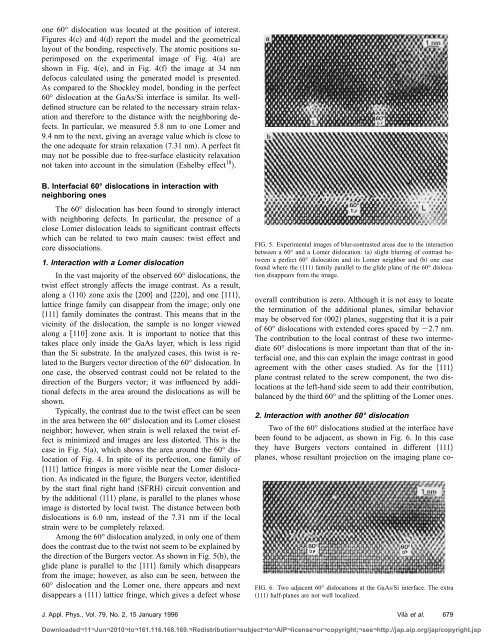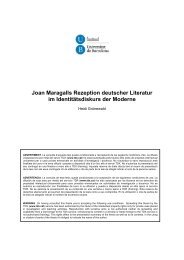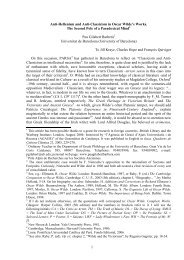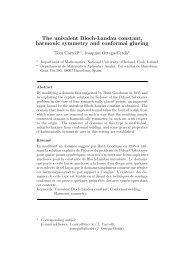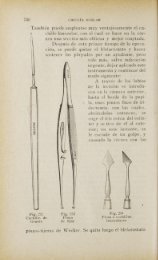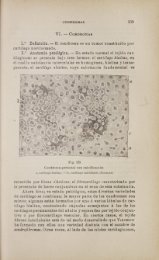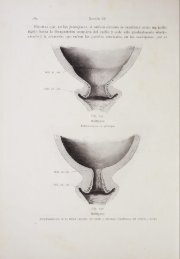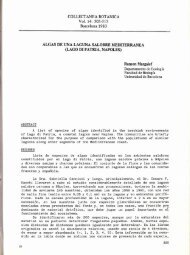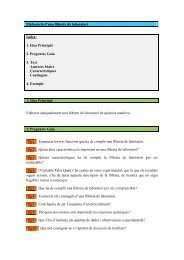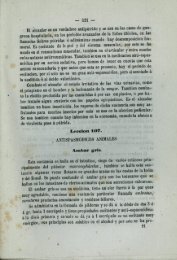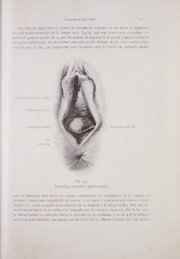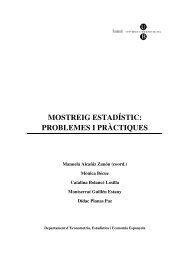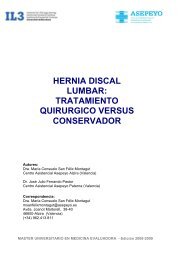Structure of 60° dislocations at the GaAs/Si interface - Universitat de ...
Structure of 60° dislocations at the GaAs/Si interface - Universitat de ...
Structure of 60° dislocations at the GaAs/Si interface - Universitat de ...
You also want an ePaper? Increase the reach of your titles
YUMPU automatically turns print PDFs into web optimized ePapers that Google loves.
one <strong>60°</strong> disloc<strong>at</strong>ion was loc<strong>at</strong>ed <strong>at</strong> <strong>the</strong> position <strong>of</strong> interest.<br />
Figures 4c and 4d report <strong>the</strong> mo<strong>de</strong>l and <strong>the</strong> geometrical<br />
layout <strong>of</strong> <strong>the</strong> bonding, respectively. The <strong>at</strong>omic positions superimposed<br />
on <strong>the</strong> experimental image <strong>of</strong> Fig. 4a are<br />
shown in Fig. 4e, and in Fig. 4f <strong>the</strong> image <strong>at</strong> 34 nm<br />
<strong>de</strong>focus calcul<strong>at</strong>ed using <strong>the</strong> gener<strong>at</strong>ed mo<strong>de</strong>l is presented.<br />
As compared to <strong>the</strong> Shockley mo<strong>de</strong>l, bonding in <strong>the</strong> perfect<br />
<strong>60°</strong> disloc<strong>at</strong>ion <strong>at</strong> <strong>the</strong> <strong>GaAs</strong>/<strong>Si</strong> <strong>interface</strong> is similar. Its well<strong>de</strong>fined<br />
structure can be rel<strong>at</strong>ed to <strong>the</strong> necessary strain relax<strong>at</strong>ion<br />
and <strong>the</strong>refore to <strong>the</strong> distance with <strong>the</strong> neighboring <strong>de</strong>fects.<br />
In particular, we measured 5.8 nm to one Lomer and<br />
9.4 nm to <strong>the</strong> next, giving an average value which is close to<br />
<strong>the</strong> one a<strong>de</strong>qu<strong>at</strong>e for strain relax<strong>at</strong>ion 7.31 nm. A perfect fit<br />
may not be possible due to free-surface elasticity relax<strong>at</strong>ion<br />
not taken into account in <strong>the</strong> simul<strong>at</strong>ion Eshelby effect 18 .<br />
B. Interfacial <strong>60°</strong> <strong>disloc<strong>at</strong>ions</strong> in interaction with<br />
neighboring ones<br />
The <strong>60°</strong> disloc<strong>at</strong>ion has been found to strongly interact<br />
with neighboring <strong>de</strong>fects. In particular, <strong>the</strong> presence <strong>of</strong> a<br />
close Lomer disloc<strong>at</strong>ion leads to significant contrast effects<br />
which can be rel<strong>at</strong>ed to two main causes: twist effect and<br />
core dissoci<strong>at</strong>ions.<br />
1. Interaction with a Lomer disloc<strong>at</strong>ion<br />
In <strong>the</strong> vast majority <strong>of</strong> <strong>the</strong> observed <strong>60°</strong> <strong>disloc<strong>at</strong>ions</strong>, <strong>the</strong><br />
twist effect strongly affects <strong>the</strong> image contrast. As a result,<br />
along a 110 zone axis <strong>the</strong> 200 and 220, and one 111,<br />
l<strong>at</strong>tice fringe family can disappear from <strong>the</strong> image; only one<br />
111 family domin<strong>at</strong>es <strong>the</strong> contrast. This means th<strong>at</strong> in <strong>the</strong><br />
vicinity <strong>of</strong> <strong>the</strong> disloc<strong>at</strong>ion, <strong>the</strong> sample is no longer viewed<br />
along a 110 zone axis. It is important to notice th<strong>at</strong> this<br />
takes place only insi<strong>de</strong> <strong>the</strong> <strong>GaAs</strong> layer, which is less rigid<br />
than <strong>the</strong> <strong>Si</strong> substr<strong>at</strong>e. In <strong>the</strong> analyzed cases, this twist is rel<strong>at</strong>ed<br />
to <strong>the</strong> Burgers vector direction <strong>of</strong> <strong>the</strong> <strong>60°</strong> disloc<strong>at</strong>ion. In<br />
one case, <strong>the</strong> observed contrast could not be rel<strong>at</strong>ed to <strong>the</strong><br />
direction <strong>of</strong> <strong>the</strong> Burgers vector; it was influenced by additional<br />
<strong>de</strong>fects in <strong>the</strong> area around <strong>the</strong> <strong>disloc<strong>at</strong>ions</strong> as will be<br />
shown.<br />
Typically, <strong>the</strong> contrast due to <strong>the</strong> twist effect can be seen<br />
in <strong>the</strong> area between <strong>the</strong> <strong>60°</strong> disloc<strong>at</strong>ion and its Lomer closest<br />
neighbor; however, when strain is well relaxed <strong>the</strong> twist effect<br />
is minimized and images are less distorted. This is <strong>the</strong><br />
case in Fig. 5a, which shows <strong>the</strong> area around <strong>the</strong> <strong>60°</strong> disloc<strong>at</strong>ion<br />
<strong>of</strong> Fig. 4. In spite <strong>of</strong> its perfection, one family <strong>of</strong><br />
111 l<strong>at</strong>tice fringes is more visible near <strong>the</strong> Lomer disloc<strong>at</strong>ion.<br />
As indic<strong>at</strong>ed in <strong>the</strong> figure, <strong>the</strong> Burgers vector, i<strong>de</strong>ntified<br />
by <strong>the</strong> start final right hand SFRH circuit convention and<br />
by <strong>the</strong> additional 111 plane, is parallel to <strong>the</strong> planes whose<br />
image is distorted by local twist. The distance between both<br />
<strong>disloc<strong>at</strong>ions</strong> is 6.0 nm, instead <strong>of</strong> <strong>the</strong> 7.31 nm if <strong>the</strong> local<br />
strain were to be completely relaxed.<br />
Among <strong>the</strong> <strong>60°</strong> disloc<strong>at</strong>ion analyzed, in only one <strong>of</strong> <strong>the</strong>m<br />
does <strong>the</strong> contrast due to <strong>the</strong> twist not seem to be explained by<br />
<strong>the</strong> direction <strong>of</strong> <strong>the</strong> Burgers vector. As shown in Fig. 5b, <strong>the</strong><br />
gli<strong>de</strong> plane is parallel to <strong>the</strong> 111 family which disappears<br />
from <strong>the</strong> image; however, as also can be seen, between <strong>the</strong><br />
<strong>60°</strong> disloc<strong>at</strong>ion and <strong>the</strong> Lomer one, <strong>the</strong>re appears and next<br />
disappears a 111 l<strong>at</strong>tice fringe, which gives a <strong>de</strong>fect whose<br />
FIG. 5. Experimental images <strong>of</strong> blur-contrasted areas due to <strong>the</strong> interaction<br />
between a <strong>60°</strong> and a Lomer disloc<strong>at</strong>ion: a slight blurring <strong>of</strong> contrast between<br />
a perfect <strong>60°</strong> disloc<strong>at</strong>ion and its Lomer neighbor and b one case<br />
found where <strong>the</strong> 111 family parallel to <strong>the</strong> gli<strong>de</strong> plane <strong>of</strong> <strong>the</strong> <strong>60°</strong> disloc<strong>at</strong>ion<br />
disappears from <strong>the</strong> image.<br />
overall contribution is zero. Although it is not easy to loc<strong>at</strong>e<br />
<strong>the</strong> termin<strong>at</strong>ion <strong>of</strong> <strong>the</strong> additional planes, similar behavior<br />
may be observed for 002 planes, suggesting th<strong>at</strong> it is a pair<br />
<strong>of</strong> <strong>60°</strong> <strong>disloc<strong>at</strong>ions</strong> with exten<strong>de</strong>d cores spaced by 2.7 nm.<br />
The contribution to <strong>the</strong> local contrast <strong>of</strong> <strong>the</strong>se two intermedi<strong>at</strong>e<br />
<strong>60°</strong> <strong>disloc<strong>at</strong>ions</strong> is more important than th<strong>at</strong> <strong>of</strong> <strong>the</strong> interfacial<br />
one, and this can explain <strong>the</strong> image contrast in good<br />
agreement with <strong>the</strong> o<strong>the</strong>r cases studied. As for <strong>the</strong> 111<br />
plane contrast rel<strong>at</strong>ed to <strong>the</strong> screw component, <strong>the</strong> two <strong>disloc<strong>at</strong>ions</strong><br />
<strong>at</strong> <strong>the</strong> left-hand si<strong>de</strong> seem to add <strong>the</strong>ir contribution,<br />
balanced by <strong>the</strong> third <strong>60°</strong> and <strong>the</strong> splitting <strong>of</strong> <strong>the</strong> Lomer ones.<br />
2. Interaction with ano<strong>the</strong>r <strong>60°</strong> disloc<strong>at</strong>ion<br />
Two <strong>of</strong> <strong>the</strong> <strong>60°</strong> <strong>disloc<strong>at</strong>ions</strong> studied <strong>at</strong> <strong>the</strong> <strong>interface</strong> have<br />
been found to be adjacent, as shown in Fig. 6. In this case<br />
<strong>the</strong>y have Burgers vectors contained in different 111<br />
planes, whose resultant projection on <strong>the</strong> imaging plane co-<br />
FIG. 6. Two adjacent <strong>60°</strong> <strong>disloc<strong>at</strong>ions</strong> <strong>at</strong> <strong>the</strong> <strong>GaAs</strong>/<strong>Si</strong> <strong>interface</strong>. The extra<br />
111 half-planes are not well localized.<br />
J. Appl. Phys., Vol. 79, No. 2, 15 January 1996 Vilà et al.<br />
Downloa<strong>de</strong>d¬11¬Jun¬2010¬to¬161.116.168.169.¬Redistribution¬subject¬to¬AIP¬license¬or¬copyright;¬see¬http://jap.aip.org/jap/copyright.jsp<br />
679


